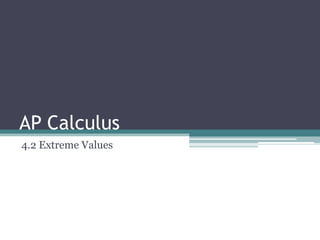
Ap calculus extrema v2
- 1. AP Calculus 4.2 Extreme Values
- 2. Applications of the Derivative • One of the most common applications of the derivative is to find maximum and/or minimum values of a function • These are called “Extreme Values” or “Extrema” • Extrema would be an excellent name for an 80’s Hair Band.
- 3. Definition • Let f (x) be a function defined on an interval I, let a ϵ I, then f (a) is • Absolute minimum of f (x) on I, if f (a) ≤ f (x) for all x in I • Absolute maximum of f (x) on I, if f (a) > f (x) for all x in I • If no interval is indicated, then the extreme values apply to the entire function over its domain.
- 4. Do All Functions Have Extrema? • f (x) = x • No extrema unless the function is defined on an interval.
- 5. Do All Functions Have Extrema? • g (x) = (-x(x2 – 4))/x • Discontinuous and has no max on [a, b] a b
- 6. Do All Functions Have Extrema? • f (x) = tan x • No max or min on the open interval (a, b) a b
- 7. Do All Functions Have Extrema? • h(x) = 3x3 + 6x2 + x + 3 • Function is continuous and [a, b] is closed. Function h(x) has a min and max. b a
- 8. Definition Local Extrema a function f (x) has a: • Local Minimum at x = c if f (c) is the minimum value of f on some open interval (in the domain of f) containing c. • Local Maximum at x = c if f (c) is the maximum value of f on some open interval containing c.
- 9. Local Max and Min Local Max Local Min Local Min
- 10. Absolute and Local Max (a, f(a)) (c, f (c)) Absolute max on [a,b] (b, f(b)) Local Max a c b
- 11. Critical Points Definition of Critical Points • A number c in the domain of f is called a critical point if either f’ (c) = 0 or f’ (c) is undefined.
- 12. Fermat’s Theorem • Theorem: If f (c) is a local min or max, then c is a critical point of f. • Not all critical points yield local extrema. “False positives” can occur meaning that f’(c) = 0 but f(c) is not a local extremum.
- 13. Fermat’s Theorem f(x) = x3 + 4 Tangent line at (0, 4) is horizontal f(0) is NOT an extremum
- 14. Optimizing on a Closed Interval Theorem: Extreme Values on a Closed Interval • Assume f (x) is continuous on [a, b] and let f(c) be the minimum or maximum value on [a, b]. Then c is either a critical point or one of the endpoints a or b.
- 15. Example Find the extrema of f(x) = 2x3 – 15x2 + 24x + 7 on [0, 6]. • Step 1: Set f’(x) = 0 to find critical points ▫ f’(x) = 6x2 – 30x + 24 = 0, x = 1, 4 • Step 2: Calculate f(x) at critical points and endpoints. ▫ f(1) = 18, f(4) = -9, f(0) = 7, f(6) = 43 • The maximum of f(x) on [0, 6] is (6, 43) and minimum is (4, -9).
- 16. Graph of f(x)=2x3-15x2+24x+7 Endpoint Max (6, 43) Critical Point – local max (1, 18) Endpoint (0, 7) Critical point – local min (4, -9)
- 17. Example • Compute critical points of • Find extreme values on [0, 2]
- 18. Example • Critical point: h’(t) = 0, t = 0 • Local min (0, -1) • Endpoints: (-2, 1.44), (2, 1.44) maximums
- 19. Example • Find the extreme values of g(x) = sin x cos x on [0, π]
- 20. Example • Critical points: g’(x) = cos 2 x – sin 2 x • g’(x) = 0, x = π/4, 3π/4 • g(π/4) = ½ , max • g(3π/4) = -1/2 , min • Endpoints (0, 0), (π, 0)
- 21. Rolle’s Theorem • Assume f (x) is continuous on [a, b] and differentiable on (a, b). If f (a) = f (b) then there exists a number c between a and b such that f’(c) = 0 f(c) f(a) f(b) a c b
- 22. Example • Use Rolle’s Theorem to show that the function f(x) = x3 + 9x – 4 has at most 1 real root.
- 23. Example • If f (x) had 2 real roots a and b, then f (a) = f (b) and Rolle’s Theorem would apply with a number c between a and b such that f’(c) = 0. • However…f’(x) = 3x2 + 9 and 3x2 + 9 = 0 has no real solutions, so there cannot be a value c such that f’ (c) = 0 so there is not more than 1 real root of f (x).